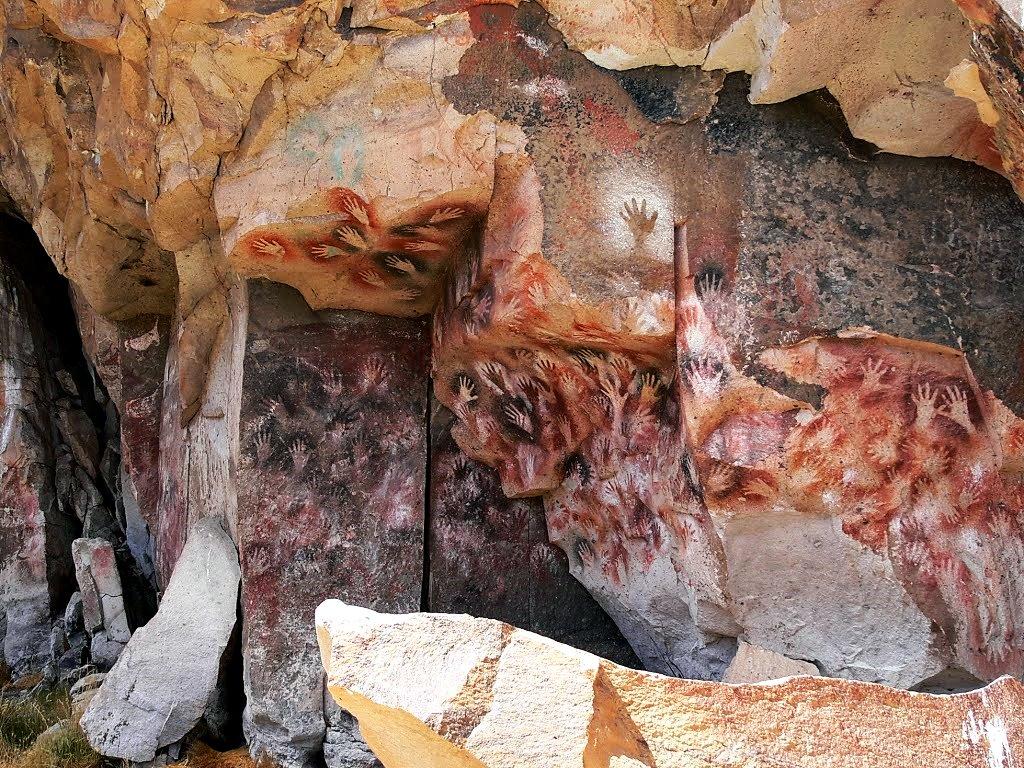
Seven thousand years before the creation of the first book and four thousand years before the Egyptians began writing their hieroglyphics on the walls of the great pyramids, the ancient Patagonian hunters left their mark, in history. Each handprint was a personal acknowledgement of a particular person's life, and each such group was a demonstration of community. The people then drew pictures around these prints depicting their daily activities, a testament to their culture.
The main food source of the prehistoric tribes that inhabited the area was guanaco, a llama-like animal that can be easily found in the area today. The rock paintings depict people hunting these creatures with primitive weapons, but with ingenious tactics. In one painting, a crack in the rock is used to depict a ravine into which the hunters drove the animals to make them easier to catch.
The pictures show lizards and spiders, pregnant animals, puppies and even evil spirits. Everything that made their world as they imagined it to be, all of it is drawn in stone.
If you could walk through these places and touch these drawings with your hand, your imagination would take you thousands of years back in time. Even if you know nothing of history, such drawings would help you create whole stories of the lives of our common ancestors. There is something fascinating about it.
You can imagine tens of thousands of years ago, gathered around a campfire, a tribe sitting around eating their guanacos. Turning the skin of slaughtered animals into clothing and painting the stories of their day's work on the stone walls that surrounded them. If you look at these images, all the scenes come to life: here, the men are chasing the animals, shouting to each other to round up the herd, to proudly bring gifts to their families.
Their stories are not lost. Their lives have not been forgotten. Their paintings are more than a diary to themselves, for they have become a preserved piece of time and a constant reminder of their former existence.
Former residents of Cueva de las Manos have become what every artist, writer and even blogger dreams of becoming: storytellers.
Cave of hands. Ancient drawings, stories from the past.

Cave of hands, located in the province of Santa Cruz in Argentina, within the boundaries of Perito Moreno National Park, which includes other sites of archaeological and palaeontological importance. Due to its uniqueness, it has been included in the prestigious UNESCO World Heritage List since 1999.
It is known for its rock engravings depicting hands that belonged to the region's original inhabitants (probably ancestors of the Tehuelche), who lived between 9,300 and 13,000 years ago. The colours are of mineral origin, so the age of the rock carvings has been calculated from the remains of the tools (made of bone) used to apply the 'paint' to the rock. The handprints are thought to have been created by impregnating a liquid pigment extracted from plants, which was blown around the hand, using a hollow bone as a tube.
Most of the hands depicted are left-handed, indicating that the authors held the ink spraying tools with their right hand. The size of the hands looks like that of a 13-year-old boy, but given that the average height of the average person at that time was less than today, it is possible that the hands belonged to people a few years older.
According to experts, it may have been part of a ritual: leaving a handprint on a possibly sacred cave wall may have signalled the transition from childhood to adulthood.
This magnificent example of rock art is located in Rio Pinturas Canyon, a deep gorge with a river running through its centre, surrounded on both sides by archaeological sites.
Although Paleolithic artworks have survived well naturally, vandalism (touching surfaces and attempts to chisel away parts of fragments) has compromised the preservation of this wonder, so the prehistoric paintings are now fenced off. The fence does not obstruct the view of these "stories in drawings", but it prevents those who want to get into history and leave their mark there from doing so. Some do get into stories... not good ones.
Cueva de las Manos is often considered an intermediate stop and a prehistoric landmark on the legendary Route 40.
From Los Antiguos it is about 176 kilometres and can be reached via Route 40 and another access road (gravel).
Estancia Cueva de las Manos is the starting point for a spectacular cave walk.


 and then
and then 
